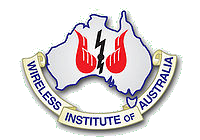| State/Territory | |
|---|---|
| Q | Queensland |
| N | New South Wales |
| C | Canberra |
| V | Victoria |
| T | Tasmania |
| D | Northern Territory |
| S | South Australia |
| W | Western Australia |
This is a list of Australian television callsigns. When a television broadcaster in Australia is granted a licence, a callsign consisting of a unique series of letters and numbers is allocated by the Australian Communications and Media Authority and are unique for each broadcast station. [1]
For commercial networks, these are generally three letters. The first two letters are selected by the licensee; and the third letter often indicates the state or territory in which the station is located. Sometimes the third letter is also used as part of the abbreviation or mnemonic to name the station - for example GTV (General Television Corporation) represents "General TeleVision" or "General TV", although the V stands for Victoria.
Callsigns in Australia do not include ITU prefixes. If one is required, "VL" is used. So, for example, GTV in an international context would actually be "VLGTV".
With the onset of aggregation in regional areas, and now digital television, the callsigns do not retain the meaning that they did in the past. Stations will sometimes change frequency, or have different frequencies at different locations, such as re-transmission sites, where the same signal is re-broadcast in a different area. However, the three-letter codes have generally not changed and are still used within the industry.
A list of callsigns is shown below, with original explanations of the callsigns as of October 2019. [2]

As early as 1929, two Melbourne commercial radio stations, 3UZ and 3DB were conducting experimental mechanical television broadcasts - these were conducted in the early hours of the morning, after the stations had officially closed down. In 1934 Dr Val McDowall at amateur station 4CM Brisbane conducted experiments in electronic television.

WIN Television is an Australian television network owned by WIN Corporation that is based in Wollongong, New South Wales. WIN commenced transmissions on 18 March 1962 as a single Wollongong-only station, and has since expanded to 24 owned-and-operated stations with transmissions covering a larger geographical area of Australia than any other television network except for ABC Australia which broadcasts to 44 countries, making it the largest privately owned television network in the world. As a regional broadcaster, WIN currently holds a seven year affiliation agreement with metropolitan broadcaster Nine Network.

The Wireless Institute of Australia (WIA) was formed in 1910, and is the first and oldest national amateur radio society in the world. It represents the amateur radio operators of Australia as the AR "peak body" in dealings with the Australian Communications and Media Authority (ACMA), the authority under the government of Australia that administers communications within and external to Australia. The WIA publishes a bi-monthly journal for its membership called Amateur Radio. The organisation is the national society representing Australia in the International Amateur Radio Union.
TVT is Tasmania's first television station, delivering its first official broadcast on 23 May 1960. The callsign stands for "TeleVision Tasmania". Unlike the commercial stations in Sydney, Brisbane, Melbourne, Adelaide, and later Perth, TVT held a monopoly in the Hobart market for many years.
Prime7 is an Australian television network owned by Prime Media Group, and an affiliate of the Seven Network. Prime Television launched on 17 March 1962 as CBN-8 in Orange, and has since expanded to cover regional New South Wales, Victoria and the Australian Capital Territory.

TND is a television station in Darwin, Northern Territory. The station, launched in 1998 as Seven Darwin and broadcasting across Darwin, Palmerston and surrounding areas, is owned by Southern Cross Austereo. Its main competitor is the Nine Network's owned-and-operated station, NTD.
GWN7 is an Australian television network owned by the Prime Media Group serving all of Western Australia outside metropolitan Perth. It launched on 10 March 1967 as BTW-3 in Bunbury, where it is still based. An affiliate of the Seven Network, it serves one of the largest geographic television markets in the world—almost one-third of the continent. The network's name, GWN, is an acronym of Golden West Network, the network's name from 1979 to when the current name was adopted in 2011.

Grant Broadcasters is an Australian regional radio network that also includes a small number of metropolitan radio stations. It is a privately owned company, held by Janet Cameron and her family.
In Australia, regional television is the local television services outside of the five main Australian cities.

Southern Cross Media Group Limited, doing business as Southern Cross Austereo, is an Australian media company which operates broadcast radio and television stations. It is the largest radio broadcaster in Australia, operating 86 radio stations, and has a reach into every state and territory.
Imparja Television (IMP) is an Australian television station servicing remote eastern and central Australia, and the Mitta & Eskdale region in the heart of the Victorian high country. Broadcasting began on 2 January 1988. It is based in Alice Springs, where it has a studio and satellite uplink facility. Notably, it is controlled by Australian Aboriginals through ownership by Imparja Television Pty Ltd, and is widely regarded as a symbol of Aboriginal Australia. Most viewers receive Imparja via free to view satellite transmission, whilst a smaller proportion receive it via analogue terrestrial transmission.
Indigenous Community Television (ICTV) is an Australian free-to-view digital television channel on the Viewer Access Satellite Television service. It broadcasts television programs produced by, and for, indigenous people in remote communities. The channel is owned by membership-based company Indigenous Community Television Limited. Although ICTV is a community television channel by name and content, it broadcasts using an open-narrowcast licence instead of a standard community television licence.
VTV is an Australian television station broadcasting in regional Victoria in Australia. The network was owned by ENT Ltd., before being purchased by the WIN Corporation.

QQQ is an Australian television station broadcasting in remote central and eastern areas of Australia, owned by Southern Cross Austereo. The station is available via satellite and terrestrial platforms – mostly through community retransmission sites, although it also transmits into the town of Mount Isa, Queensland under the call sign ITQ. The station is solely affiliated with the Seven Network.

This timeline of Australian television lists important station launches, programs, major television events, and technological advancements that have significantly changed the forms of broadcasting available to viewers of television in Australia. The history of television in Australia can be traced back to an announcement from the Menzies' government concerning plans for television services in Sydney and Melbourne.
Call signs in Australia are allocated by the Australian Communications and Media Authority and are unique for each broadcast station. The use of callsigns on-air in both radio and television in Australia is optional, so many stations used other on-air identifications. Australian broadcast stations officially have the prefix VL- and originally all callsigns used that format, but since Australia has no nearby neighbours, this prefix is no longer used except in an international context.

87.8 UCFM is an independent student radio station transmitting from the campus of the University of Canberra. It broadcasts a professionally consulted College Radio niche music format - 24 hours a day, seven days a week, with a mix of news and current affairs. The radio station's studios are located within the lower level of "The Hub" complex on the university's Bruce campus, in Australia's capital city - Canberra.
Mt. Helen FM was a community radio station, serving the Upper Hunter and Liverpool Plains areas of New South Wales. It operated studios in Willow Tree and Muswellbrook, and operated from transmitters serving both areas.
CDT is an Australian digital television station broadcasting in remote central and eastern Australia. It is jointly owned by Southern Cross Austereo and Imparja Television Pty Ltd and operates under the company name Central Digital Television.
Broadcast call signs are call signs assigned as unique identifiers to radio stations and television stations. While broadcast radio stations will often brand themselves with plain-text names, identities such as "cool FM", "rock 105" or "the ABC network" are not globally unique. Another station in another city or country may have a similar brand, and the name of a broadcast station for legal purposes is normally its internationally recognised ITU call sign. Some common conventions are followed around the world.